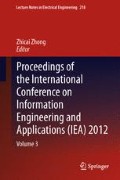Abstract
The method of separating bromine using emulsion liquid membrane is described. The effects of various experimental parameters, such as the concentration of surfactant and internal phase reagent, the proportion of oil and internal phase reagent, and the proportion of emulsion and water have been studied in detail. With Blue 113-B as surfactant, kerosene as the membrane solvent, Na2CO3 as the internal phase reagent, N7301 as carrier, bromine is extracted by emulsion liquid membrane system. The migration mechanism is discussed; the best operating conditions for the separation: the surface-active agent dosage Blue 113-B is 2–3 %, N7301 dosage as carrier is 2 %, the appropriate proportion of emulsion and water is 1:30, the appropriate proportion of oil and internal phase reagent is 5:5. In the best operating conditions, the extraction efficiency could achieve 98 %; after the breaking, bromine recovery can reach 95 %.
Access this chapter
Tax calculation will be finalised at checkout
Purchases are for personal use only
References
Li NN, Somerset NJ (1968) Separating hydrocarbons with liquid membrane, vol 12. US Patent 3419794, pp 46–56
Draxler J, Fürst W, Marr R (1988) Separation of metals species by emulsion liquid membranes. J Membr Sci 38:281–288
Nakashio F (1993) Recent advances in separation of metals by liquid surfactant membrane. J Chem Eng Jpn 26:123–133
Huang CR, Wang KC, Zhou DW (1996) Chemical separations with liquid membranes: mathematical modeling of carrier-facilitated transport in emulsion liquid membranes. Am Chem Soc 642:115–128 (Washington)
Schiffer DK, Hochhauser A, Evans DF, Cussler EL (1974) Concentrating solutes with membranes containing carries. Nature 250:484–492
Kumbasar RA (2009) Recep A Selective extraction and concentration of cobalt from acidic leach solution containing cobalt and nickel through emulsion liquid membrane using PC-88A as extractant 3:479–483
Author information
Authors and Affiliations
Corresponding author
Editor information
Editors and Affiliations
Rights and permissions
Copyright information
© 2013 Springer-Verlag London
About this paper
Cite this paper
Wang, H., Xiao, C.Y., Zhao, B. (2013). Separation of Bromine by Liquid Surfactant Membranes. In: Zhong, Z. (eds) Proceedings of the International Conference on Information Engineering and Applications (IEA) 2012. Lecture Notes in Electrical Engineering, vol 218. Springer, London. https://doi.org/10.1007/978-1-4471-4847-0_10
Download citation
DOI: https://doi.org/10.1007/978-1-4471-4847-0_10
Published:
Publisher Name: Springer, London
Print ISBN: 978-1-4471-4846-3
Online ISBN: 978-1-4471-4847-0
eBook Packages: EngineeringEngineering (R0)

